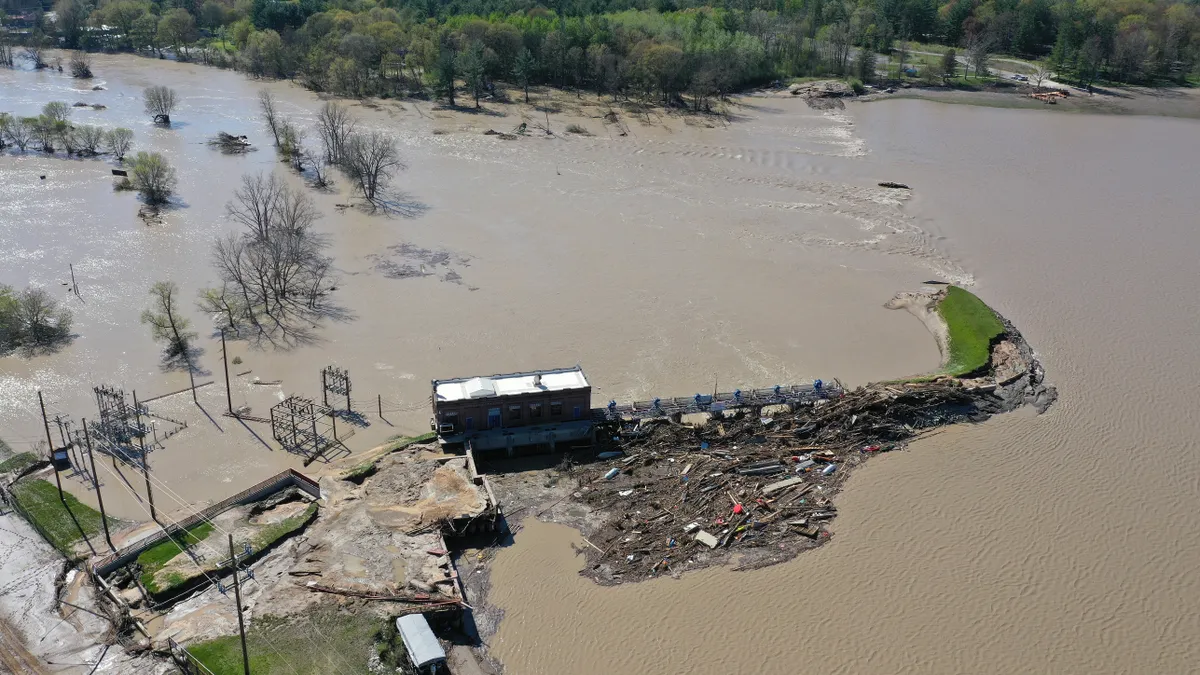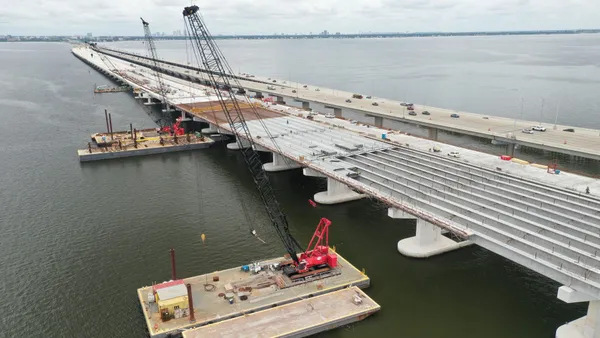Dive Brief:
- New details about the 2020 Edenville and Sanford dam failures in central Michigan have recently come to light as the state moves through the discovery process of its federal lawsuit against the former dam owner. In 2010, owner Boyce Hydro allegedly determined that the east embankment of Edenville Dam might fail if Wixom Lake rose too high and made plans to fix it, but did not follow through, according to court filings. That same area failed in May 2020.
- The embankment collapse emptied the lake, forcing 10,000 people to be evacuated and causing $175 million in damage to downstream homes. There is no indication that Boyce Hydro previously divulged the defect to the federal government, which regulated the dam at the time, nor did it alert the state after it took over regulation in September 2018, per the discovery document. The document alleges owner Lee Mueller and his company Boyce Hydro are fully to blame for the dam failure.
- But Mueller countered in an email to Construction Dive that it was actually the state's environmental agencies that were to blame for the dam's failure, and that the state is trying to shift responsibility to him to protect itself from litigation from flood victims.
Dive Insight:
The Michigan State Attorney General’s office filed a brief in support of a motion for summary judgment on May 25 on behalf of the Michigan Department of Natural Resources and the Michigan Department of Environment, Great Lakes, and Energy, which are suing Mueller and various companies associated with him.
In his email, Mueller said the state’s claims that he knew in 2010 about the dam’s potential for failure and neglected to tell the relevant authorities “are entirely false.”
"The press release and the fictional narrative that has been concocted in the attorney general’s motion for summary judgment are in part the product of uncorroborated hearsay," Mueller said in the email.
In February, the federal court sanctioned Mueller for numerous failures to obey discovery orders and provide information about the dam failure, saying he “engaged in bad faith and/or contumacious conduct.”
The goal of the lawsuit is to prove Mueller’s liability for the dam’s failure and get financial restitution, but Mueller has claimed fiscal hardship and may not have enough money to pay even if he is proven responsible.
Mueller said after the Federal Energy Regulatory Commission revoked the dam’s hydropower generator license in 2018, he lowered the reservoir’s water level until additional spillway capacity could be constructed, but the Michigan Department of Natural Resources and the Michigan Department of Environment, Great Lakes, and Energy's Dam Safety Unit forced him to bring it back up. He claimed leaving it lowered would have prevented the failure.
The state’s document claimed that Boyce Hydro’s former dam safety engineer and chief operator resigned in protest in 2017 because Mueller allegedly neglected safety measures in favor of various efforts to make a profit. The engineer tried to persuade Mueller to fix the embankment, and expressed frustration over his pursuit of projects like a sawmill, marina and a music festival, according to the filing.
The chief operator testified that he told Mueller that, “You’re in the hydro business now, you got to pay attention,” according to the brief. Mueller allegedly responded, “I’m not in the hydro business. I’m in the money-making business.” The chief operator resigned in 2017 after Mueller started making plans to dig a pond and develop a subdivision in the area, the document asserts.
This is not the only lawsuit related to the Edenville Dam failure. In April, dozens of area residents filed a lawsuit against FERC alleging it didn't follow its obligations, and said that dereliction was a major contributing factor to the incident.
Private dam failures a big risk
Last year, FERC's independent forensic team released a report that found that the Edenville incident was "foreseeable and preventable." A key embankment was compacted improperly when the dams were built in the 1920s, setting them up to fail, and a combination of factors enabled the disaster a century later. However, unlike the assertions in the state’s recent filing, FERC said blame was not easy to assign.
“The failure cannot reasonably be attributed to any one individual, group, or organization. Instead, it was the overall system for financing, designing, constructing, operating, evaluating, and upgrading the four dams, involving many parties during the nearly 100 years of project history, which fell short in ensuring a safe dam at the Edenville site,” the report stated.
In addition, there is evidence that more dams may be at risk of failures. The Edenville and Sanford dams were listed by FERC as high-hazard, and there are more than 15,000 high-hazard dams owned by entities other than the federal government across the U.S., according to the Association of State Dam Safety Officials. It would cost $157.5 billion to rehabilitate the nation’s 88,616 deficient non-federal dams — which dwarfs the amount of funding available — and that price tag is only rising, per a 2023 ASDSO report.
As of 2019, 56.4% of U.S. dams were privately owned, per the American Society of Civil Engineers, and repairs on these dams can be difficult as regulators have little leverage over owners who don’t have the money or desire to make repairs. The Infrastructure Investment and Jobs Act provides another $4 billion for rehabilitation, but it’s not nearly enough to address even the most dangerous of dams.
This story has been updated with comments from Lee Mueller.















